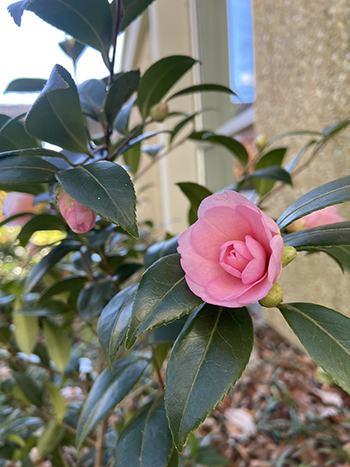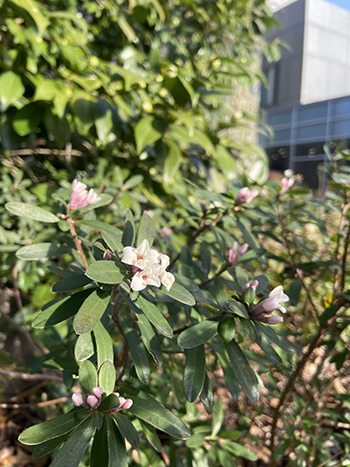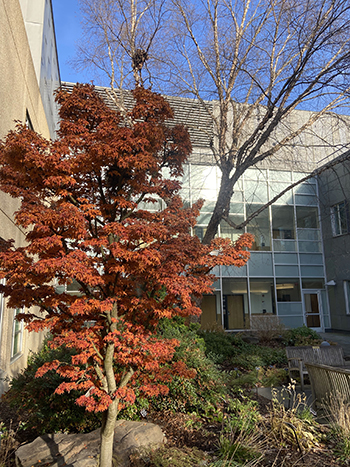
Plants of the Week: December 5

Camellia sasanqua ‘Fall Fantasy’ – sasanqua camellia
I’ll admit… I knew nothing about camellias before my time here at Scott Arboretum. But now I’m hooked! Every week when I go out on my walks to look for plant selections, I cannot help but select the latest blooming specimen to write about. This week’s prized beauty is Camellia sasanqua ‘Fall Fantasy’.
Nestled in the Harry Wood Garden in the northwest corner, this adorably compact shrub is one you may have to crouch down to get a good look at. Its delicate beauty is the product of more than 30 years of breeding, and was not released until 2017. It was first produced by Clifford Parks who started breeding this camellia in the 1980s with the cross between Camellia ‘Snow Flurry’ and C. ‘William Lanier Hunt’. Selected for its prolific and long season of bloom, I think this camellia was worth the long breeding process.
Blooming in incredible abundance, Camellia sasanqua ‘Fall Fantasy’ flowers have translucent pink petals that fade into white as your eye moves from the inside of the bud out. Layers of delicate softness make this bloom stunning against its leathery green, evergreen foliage. Reaching a height of 7-8 feet this sasanqua camellia is cold hardy up to Zone 6 and blooms starting in early fall, sometimes lasting through to spring. Photo credit: M. Rossman

Daphne x transatlantica ‘Blafra’ – Eternal FragranceⓇ daphne
While sitting on a rock the other day in the Harry Wood Garden I received a photo from my folks at their house in the mountains of Colorado. They had just received 11 inches of snow overnight. While stunned at the image of the snow accumulation on their porch, I leaned over to smell the blooming Daphne x transatlantica ‘Blafra’ and contemplated which scenario – the snow or the Daphne – was a more enjoyable experience for the start of December.
Growing in Zones 5-9, this small, rounded shrub is well known for its intensely fragrant flowers. Small profusions of light-pink and white blooms arrive in clusters, starting in spring and continuing to bloom well into the fall and early winter. The flowers, which take on slightly darker pink and purple hues when temperatures turn cold, are accompanied by semi-glossy, narrow, dark-green leaves.
A bit finicky when getting established, the Eternal FragranceⓇ daphne is best grown in moist, well-drained soils, in areas where it can be protected from cold winter winds. Daphnes are often slow to establish and are best left undisturbed once planted. Consider planting in raised areas to provide the necessary drainage while still finding a site where you can get up close to enjoy their fragrance.
I have been delighting in the fragrant winter blooms that the Scott Arboretum has to offer and the Daphne x transatlantica ‘Blafra’ has certainly been added to the list. And while I can’t decide between the Colorado snow or the December blooms of the mid-atlantic, I can say for certain that they each bring their own joys to the winter season. Photo credit: M. Rossman

Acer palmatum ‘Shishigashira’ – Japanese maple
And here I thought the fall color was done! Yet another specimen in the Harry Wood Garden has taken me by surprise. In the rear northeast corner of this courtyard space is a highly sculptural tree with a cultivar name meaning lion’s head.
The Acer palmatum ‘Shishigashira’ is a dream in burnt umber, its tufts of palmate leaves create a highly unique form. Popular for bonsai, as a container specimen, and in small gardens, this Japanese maple grows in Zones 5-8 reaching a height of 7-15 feet with a spread of 5-12 feet. Many of our Japanese maples had lackluster fall displays due to our drought conditions, however Acer palmatum ‘Shishigashira’ is less likely to sunburn than other varieties. This, in combination with its protected location within the Harry Wood Garden, has led to its stunning December display. Photo credit: M. Rossman





Alan Kruza
Posted at 10:37h, 15 DecemberExcellent blog, Megan. Soon, the Chimonanthus will be blooming and I think you will love the fragrance. Keep up the good work.